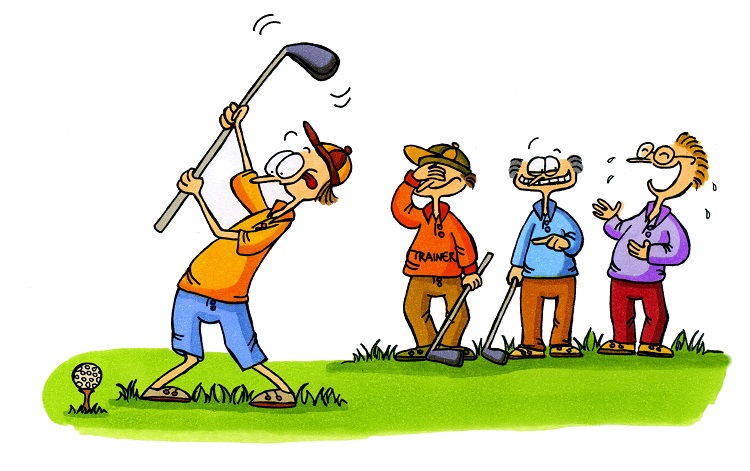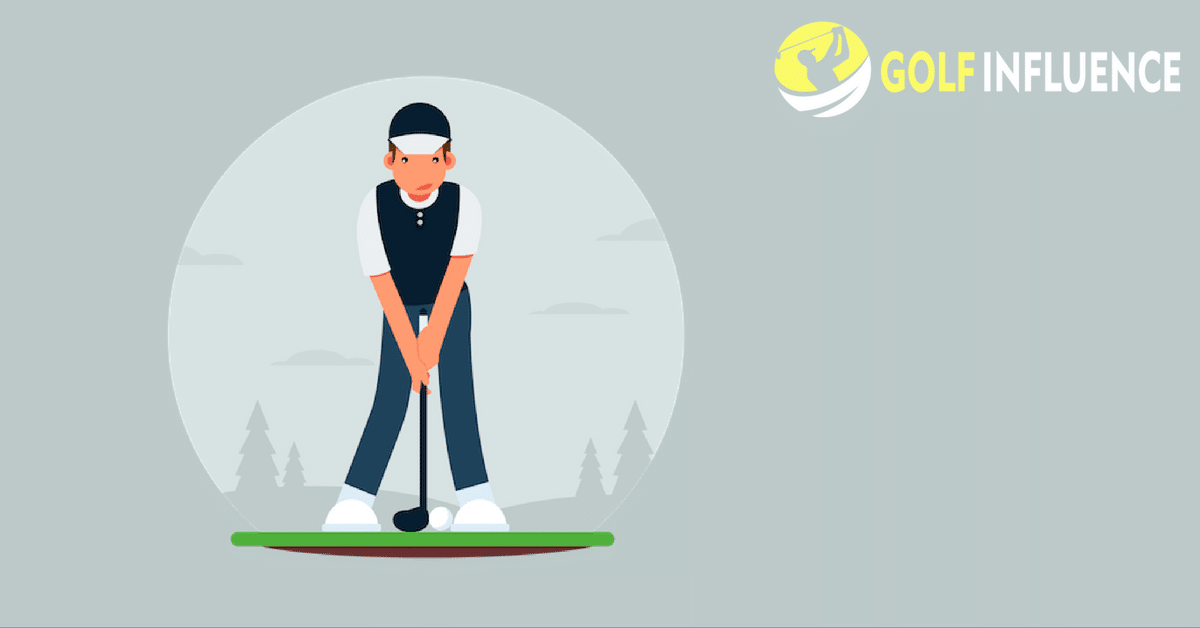How to Grip Golf Club: The Definitive Guide
Fundamentals in golf are extremely important, but often overlooked.
With the proper fundamentals in place, making a repeatable golf swing can be made easier, eliminating the need for extra instruction.
Having a sound grip is imperative. When you finish reading this article, you’ll have everything you need to know about how to grip the golf club properly.

Don’t have time to read the whole guide right now?
No worries. I can send you a digital copy so you can read it when it’s convenient for you. Just let me know where you’d like me to send it to (takes 3 seconds).

What You Will Learn In This Post
CHAPTER 1
First Things First: Equipment Matters
Before you focus on the keys to a great grip, you need to make sure the grips on your clubs are the right size.
You also need to make sure that they are composed of the right materials for your game, your hand texture, and for where you play.
Let’s see how you can easily pull this off.

How To Get Properly Fit For Your Grips
There are two simple ways you can get fit properly for your grips and have a proper golf grip.
#1: Local is Best

The first option is to go to your local golf retail shop, and ask one of the attendants to measure your hands to determine which size grip is right for you.
This option is best because once you’ve determined the right-sized grip, the attendant can show you all the grips in stock that fit those specifications, allowing you to see how each grip feels in your hands.
Feel, in golf, is everything, and having something that feels good in your hands is the first step in mastering your grip.
#2: If You Have No Choice, Buy Grips Online
If you don’t have a retail golf shop nearby, searching online allows you to find the right grip for your game.
All you need is a ruler to measure your hands, input the information, and you’ll find several grips designed with your hands in mind!
While this is certainly more convenient than having to hop in your car and drive somewhere, you don’t have the advantage of trying out the feel of different grips.
In this instance, your best bet would be to find a golf grip you think you’ll like, buy one for a golf club you use often, change it, and test it out.

If you like it, get the rest of your set changed, and enjoy! If it’s not what you were looking for, find another golf grip online and try again.
While this may seem tedious, simply buying a full set of grips because it looks good on a website is asking for trouble.
For a great interactive guide that will help you find a perfect grip based on your preferences and climate, check out the Lamkin Golf Grip Size Selector.
Pro Tip: Have The Same Golf Grip On All Your Clubs
Unless you have a specific reason to keep a certain grip on a specific club, it’s best to have the same grip on all your clubs (putter excluded).
How Should The Grip Feel?
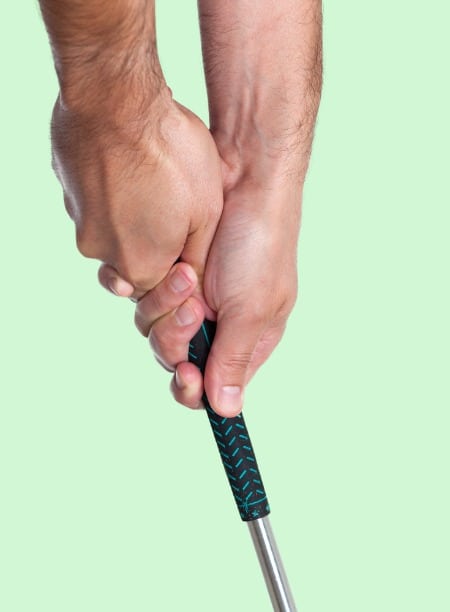
In general, the golf grip should feel secure in your hands, with the tips of your middle and ring fingers barely touching each palm.
With size adjustments, you can also affect the ball flight.
For example, if you like to hit a fade, a larger golf grip width will make it tougher for your hands to rotate through, promoting a slightly open clubface.
Conversely, with a narrower golf grip width, the club face will have an easier time closing slightly, which can help produce a draw.
Above all else, the golf grip must feel comfortable in your hands and must give you confidence that you can execute any shot you desire with them.
Choosing a golf grip that merely looks cool or that you were pressured into buying accomplishes neither of those goals and is a recipe for trouble.
A cheap golf grip you believe in is much better than the latest high-end grip that feels awkward or doesn’t give you confidence.
Once you have your sweet new grips on your clubs, we can delve into the mechanics of a proper golf grip.
CHAPTER 2
The Top Hand
The role of the top hand is to provide an anchor of support to the golf club.
This is often misunderstood by many amateurs players.
Without proper support from the top hand, it is hardly impossible to properly grip the golf club.
In this chapter, we’ll take a deep dive into makes a great top hand grip.
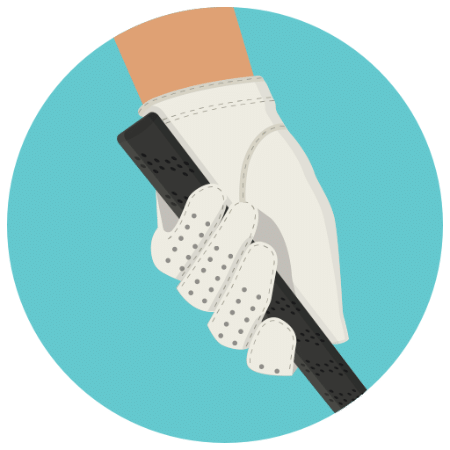
The Anchor
One area many golfers struggle with in regards to the grip is having enough strength in what is typically the less dominant hand of a player’s physique.
It starts with the right pressure points.
For a solid grip, it should typically be held firmly within the pinky and ring fingers of the top hand. As you can already assume, the fingers farthest from the thumb are typically the weakest.
Case Study:
Jordan Spieth Uses a Unique Grip to Be Super Accurate. Should You?
There’s no doubt how talented young Jordan Spieth is, and he’s proven it with the hottest start to a PGA Tour career since Tiger.
If you’ve spent any amount of time watching Jordan play, you’ll notice he’s not like most superstars on Tour.
He is typically one of the shorter hitters (especially in the world of Dustin Johnson and Rory McIlroy), but his accuracy is in another realm.
One of the ways he achieves his incredible accuracy with what would be considered a “weak” top hand.
The benefit of a weak top hand is being able to have more control of the clubface, allowing you to hit fades and draws more on command. Jordan certainly utilizes this benefit to its maximum potential.
The most prominent downside is it doesn’t provide much in the way of leverage, which is one way a player generates distance.
Jordan is by no means a short hitter by most standards, but for someone as athletic and well-conditioned as he is could certainly hit it longer if he wanted.
The question still remains: is this a grip you should use?
One thing to remember is this grip style is probably something he either gravitated to naturally or spent many years and thousands of hours of dedicated practice to cultivate.
If it’s something you’re willing to dedicate the time to mastering and have the time to work on it, you’ll find a grip like Jordan Spieth’s will make you amazingly accurate.
Are Your Fingers Strong Enough?
Without plenty of support in this area of your top hand, there are two key areas where things can break down:
- First, the top hand will have a tendency to break down in the middle of the downswing, which fill force the bottom hand to take over. This will most likely result in a scooped shot, sending the ball on a higher trajectory, robbing you of distance and accuracy.
- If a scoop isn’t in your arsenal, another possibility is the rest of your arm, wanting to compensate, will lift up, which can cause the dreaded “chicken-wing” follow-through, leaving the clubface open.
No matter which of these affects your game, having strong top hand fingers is crucial.
Drill: How To Hold The Golf Club More Securely With The Top Hand
If you want to hold the golf club more securely in the top hand, there are a couple strengthening exercises you can do that, with just a few minutes of practice a day, can help build up enough strength in the pressure point fingers.
First, start with a wet dish towel. Hold the towel at the tip with your opposite hand and, using only the pinky and ring fingers of your top hand, try to wring out as much water as you can.
Once that gets easier, you can practice by holding onto the golf club with those same fingers, making certain to keep the other fingers off the grip.
Start with the clubhead on the ground (as if you were addressing the ball), then slowly raise the golf club up until you feel your muscles working. Hold for 10 seconds, then slowly lower the club back down to the ground.
Repeat twice more. Just those thirty seconds can make a big difference in securing the club.
Natural Is Best
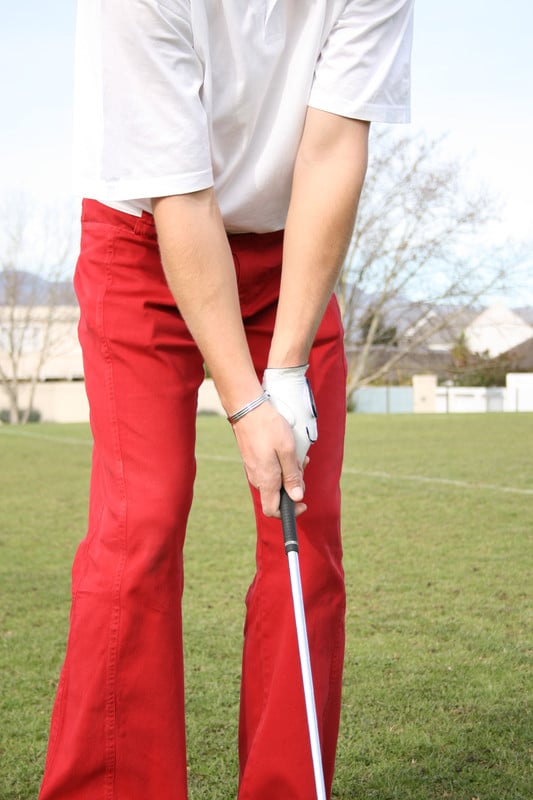
The easiest way to hold the golf club in your top hand is to make it as natural as possible.
Balance the golf club on the ground with your bottom hand, using only two fingers at the base of the grip.
With the clubface square, wrap your pinky finger around the top of the grip, then close the rest of your hand on top of the grip.
Your index finger should gently touch your palm just below the base of your thumb. To test if your hand is seated properly, cock your wrist straight up in the air.
If you’re able to fully cock your wrist without any resistance, you know your grip is correct.
What About The Rest Of Your Hand?
Since most of the weight in the golf club is carried by the two fingers at the back of your hand, the other three and the rest of your palm are simply along for the ride.
The other important factor to consider is how the hand sits in relation to the clubface.
Once we have the bottom hand figured out, you’ll learn how the “V”s formed by each hand’s thumb and index finger and how they fit together.
CHAPTER 3
The Bottom Hand
While the top hand serves as the anchor which holds everything together, the bottom hand acts as the proverbial driver on the steering wheel, the guide of the golf club.
Before we get into the nuts and bolts of how to bring both your hands together, it’s important to understand how the right hand acts on its own, where the pressure points are, and how the “V” determines its position.

Pressure Points Matter Here, Too
The main pressure points in the bottom hand is your index finger, and that’s it.
What about the thumb?
It is merely along for the ride. Whether it sits on top of the grip, or loops over to the side, there should be no pressure placed on the shaft from your thumb.
Since the index finger on your bottom hand is, more often than not, on your dominant hand, it should be plenty strong.
If you struggle with keeping the golf club secure in this part of your hand, needing to squeeze the club with the rest of your hand, you can utilize the same strengthening exercises for the top hand to build it up.
Drill: Practice Letting Your Hands Go
While it’s common for the top hand to not be involved enough in the golf swing, the opposite is usually true of the bottom hand.
Being your dominant hand, it’s always tempting for your hand to want to “do” something: pull the golf club down, rotate your hands hard or soft, etc.
Truth is, you want to let the rest of your golf swing control the club. Your hands are just along for the ride.
One good way to limit the role of the right hand and its tendency to take control is with some one-handed chip shots. When you take your normal bottom hand grip, there should be a cap between your wrist and the rest of the grip.
Grab a few balls, and try to chip them without that gap collapsing. As you get more comfortable, you’ll be able to hit pitch shots without losing that sensation.
Take that feeling to the golf course and your bottom hand will be quieter, improving the quality of your golf shots.
CHAPTER 4
Bringing It All Together
Now that you have an idea how each hand sits on the club individually, it’s time to join them as one.
The first thing you must determine is how your top and bottom hand will integrate with each other.
Unless you’re new to golf, you’ve probably heard of the “overlap”, “interlocking”, and “baseball” grip variations.
We’ll delve into which one works best for whom and the pros and cons of each.

Which Configuration Is Right for You?
One thing you must always be conscious of is the proper golf grip pressure points.
For example, the ten-finger grip, where all your fingers make contact with the grip, creates the most sensation of “control” with the club. This can be both a good and a bad thing.
For example, if your golf club tends to move all over the place during the swing, having more contact points may help secure the club in your hands.
The problem is that, far too often, so many contact points can create inconsistencies in your grip pressure.
Overlapping grips, where the pinky of your bottom hand rests in the crease between the index and middle finger of your top hand, are usually the most popular amongst men, or anyone with larger-than-normal hands.
Bringing the hands closer together without any extra tension allows them to work more as an aligned unit, which is ideal. The con is, depending on your preference, the club will feel the least under control than the other two grips.
If you like the idea of having more of a solid connection between the hands and club, then the interlocking grip, where the same pinky from the bottom hand fits in-between the crease, will suit you best.
However, there is one downside: with the fingers interlocking, it can create some tension in the area of your intertwined fingers and knuckles. As a general rule of thumb, tension in golf, especially in the hands, is bad.
The Right Feel and Grip Pressure
What really matters when choosing a grip style is how your hands feel on the club. If it feels good, go with it.

With all this talk about pressure points, there’s still a question to be answered: Exactly how much pressure do you want to use to control the golf club?
The answer is short, but also requires some detail.
You want to use just enough pressure to hold the golf club in place and still make a free swing.
If you feel like you can’t hold the golf club comfortably without squeezing it with every knuckle as hard as you can, you may need some tackier grips (see chapter about grips above).
As long as the golf club stays secure in your hands (at the two key pressure points), there’s no real way for you to grip the club too loosely. Soft hands are the key to maximizing your distance and accuracy.
From Strong to Weak: Which One is For You?
By the way, what about those “V’s we have discussed? Depending on where they point, your grip can be classified as weak golf grip, neutral, or strong.
For example, if both “V”s point somewhere in between your strong-side shoulder and collarbone, that is considered a neutral grip.
There should be about one to two knuckles on your top hand exposed when you look down. In this position, you shouldn’t err much between a draw or a fade.
If your “V”s point more towards your strong-side shoulder, with two to three knuckles on your top hand exposed and the palm of your bottom hand facing the sky, you have what is known as a “strong” grip.
With this style, your tendency will be to produce a draw or hook.
If the “V”s point closer to your neck, no knuckles visible on your top hand and your bottom hand face-down, this is considered a “weak” grip.
Weak grips require more hand manipulation than the other two, and are common amongst those who prefer to fade the golf ball.
Which one of these is best? Aside from being listed from most common to least common, the only way a grip can be “bad” is if it goes against an individual’s build.
Case Study:
Zach Johnson, Stronger Grip for More Powerful and Accurate Tee Shots
Over a long career, Zach Johnson has amassed a stellar resume, including two major championships.
While he’s most known for his prowess with his wedges, he is also an incredible driver of the golf ball. One of the ways he achieves a repeatable tee shot is with the use of a strong grip.
Unlike Jordan Spieth, who is highlighted in our other story, Zach Johnson has his top hand rolled over to the point where he can see three knuckles on his left hand.
Like Spieth, ZJ doesn’t generate a lot of clubhead speed, but they both go about it in different ways. While Jordan uses his hands to manipulate the clubface to his liking, Zach Johnson utilizes his body rotation.
This is key because, with a strong top hand, doing anything with your hands is asking for trouble.
By using his body more than his hands, Zach can square the clubface consistently, which is something all golfers can benefit from.
Also, the stronger top hand eliminates the need to put any focus any type of hand manipulation, requiring less practice than a weaker top hand.
You may sacrifice some accuracy for the sake of simplicity. But for the recreational player, you’ll find more consistent results, especially with the driver, if you follow the Zach Johnson model.
Another example of how two players, similar in length, can make it happen in completely different ways.
Pro Tip: Once You Have It, Keep It
While a little experimenting to determine a grip that works best for you is fine, once you find something you feel comfortable with, stick with it.
If you’re in the midst of a stretch of poor golf, the grip is often the easiest thing to tweak; however, it can also be a quick fix for any of many other flaws and will only make things worse.
With everything we’ve discussed thus far, we can now get into how your hands actually fit together.
First, start by placing your top hand on the top of the golf grip as described in the above chapter.
Next, bring the golf club up to shoulder height, with your wrist cocked and your top arm extended.
Open the palm of your bottom hand and align the lines formed between the ring and pinky finger with the index finger on the bottom hand.
Finally, fold the bottom hand over the top, choosing how you want your hands to join (ten-finger, overlap, interlock).
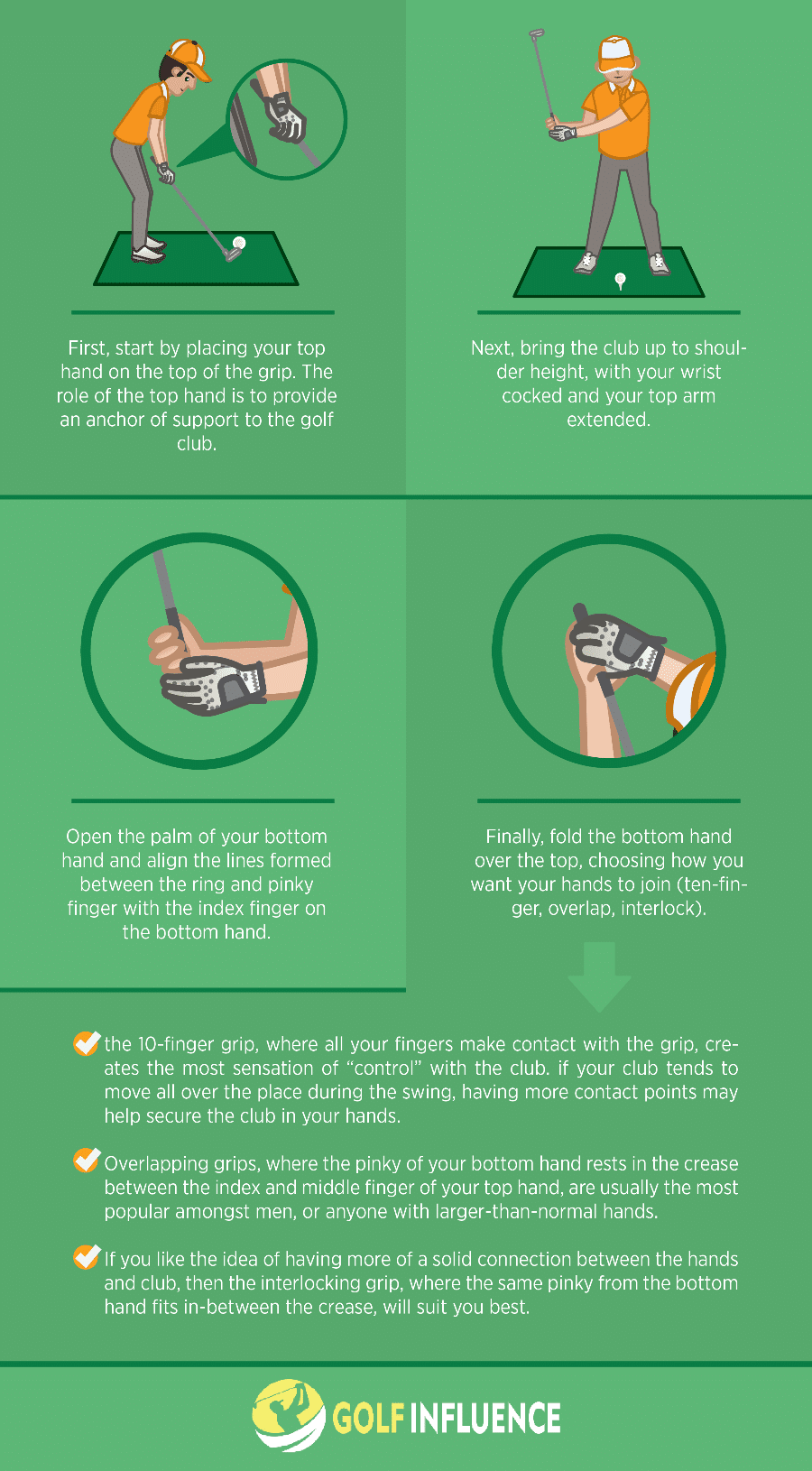
CHAPTER 5
Practicing Your Grip and Common Pitfalls
Of all the changes a golfer can make, a grip change is both the most tedious and the one change golfers are quick to give up.
It’s too easy for a player who, after a week of practice, can’t get over the uncomfortable feeling in their hands.
Usually, they’ll revert back to their old grip, then be surprised at how they don’t seem to get any better.
While a grip change is certainly not easy, if you stay diligent, what once felt awkward and uncomfortable will become second nature.

The Most Common Misconception About the Grip
One of the biggest misconceptions in golf is that a player changes or alters their grip based on the shot they need to play.
For example, if a player needs to hit a draw, it’s common for them to simply rotate their hands into a stronger position.
After numerous hours spent polishing their grip fundamentals, altering those feelings for one shot is ineffective and can throw off your feel for the rest of the round.
Rather than changing your grip based on the shot you desire to play, it’s much simpler to adjust the clubface, keeping your grip the same. If it worked for Jack Nicklaus, it can work for you too.
Pro Tip
If you want to expedite the process of making a grip change feel natural, there are a couple tricks you can utilize that will make it happen easier and faster.
Start with simple shots. Take your wedge, go to the chipping green with as many balls as your golf course will allow, and hit simple bump-and-runs, making sure your grip is how you want it before each shot.
Repetition is key. You don’t even have to be at the golf course to do this! A few balls chipped off your carpet while you’re watching TV after work will help immensely (as long as the spouse doesn’t get mad, that is).
Stay patient. Unfortunately, there’s no timetable as to how long it’ll take for the changes you’re making to not feel like a chore.
The best thing you can do, especially when you’re out on the golf course, is to be diligent. Take your time when you take your grip, then execute the shot to the best of your ability.
Until you feel completely comfortable, your results are going to be sporadic; if you’re able to accept this as a normal part of golf improvement, the easier it’ll be to focus on the long run.
Eventually, your bad shots will be better and your good shots will be great.
When a student comes to me with concerns about their golf grip, some version of this question is bound to come out:
“What do I do differently with my grip with an iron? Or my driver? How does the grip pressure change between a wedge and an iron?”
Student Of Mine
The answer is simple: aside from the putter (which we’ll cover in a bit), your grip technique, pressure points, and positions don’t change, regardless of what golf club you use.
The best way to improve your game is to keep things as simple as possible. The grip is no different.
CHAPTER 6
The Putter Grip
Having a different grip on your putter is essential.
First, putters sit on the ground differently than other golf clubs, which places your hands in a different position.
Second, the path of a putter arc is significantly different than the golf swing, which means your hands will work in a different manner than with your irons and woods.
Third, and perhaps most importantly, your personal preference when it comes to the type of putting stroke you use can be enhanced by certain styles of putter grips.

Buy Putter Grips in-Person
This is one instance where I would not recommend hopping online to find a putter grip unless you already know what you like and what suits your game.
Take a trip down to your local golf shop and see what type of grips they have available.
Hopefully, if they’re prepared, they will have a few models with different putting grips for you to try, which is much more convenient than having to:
a. hold a golf grip on its own to gauge the feel or
b. get your own putter regripped just to try them out.

How Handsy Are You on the Greens?
As a general rule-of-thumb, the less involved your hands are in your putting stroke, the wider the golf grip you’ll want to use.
If you like to forward press during your stroke or you release the putter, a standard golf grip size would be a perfect fit for you.
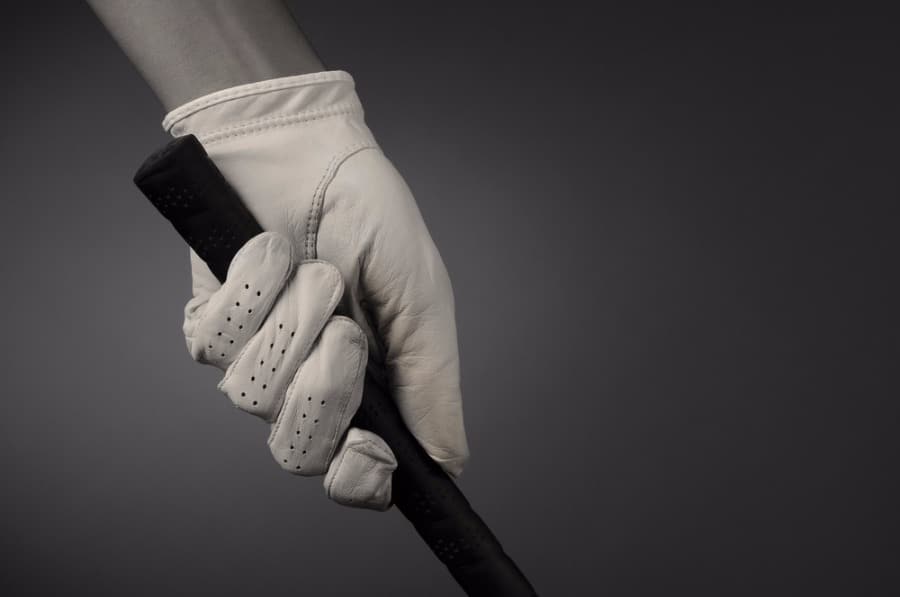
For more pendulum-like strokes, where you try to rock your shoulders and keep your hands out of it, an oversized golf grip all the way up to the box-style grips will help you maintain still hands.
Once you have the proper grip for the type of stroke you prefer to use, you still have plenty of options on how to grip the putter itself.
In the late 90s, golfers generally employed two styles of grips: conventional and cross-handed.
As time has progressed, there have been other variants, mostly designed to limit the ability of the player’s bottom hand taking over in the stroke.
For brevity purposes, I will stick to the two most popular: the Claw and the Saw.
Can’t Go Wrong With Conventional
The conventional grip is very similar to the standard golf club grip, with the exception that the grips are designed for your thumbs to sit at the top.
Rather than overlap or interlock your fingers, many golfers choose to do a reverse overlap, where the index finger of your top hand actually sits on top of your bottom hand pinky.
This brings the hands closer together, creative a more cohesive unit and helps stabilize the putter face.
The conventional grip provides awesome feel for the stroke, but also requires solid fundamentals, as mishits are far more common.
If you’re looking for more stability and better contact with your putts, you’ll want to use a cross-handed grip.
Cross-Handed For More Consistency
The cross-handed grip is simple: just move your top hand down, and your bottom hand up.
For a really stable putter face, you can move your top hand all the way to the bottom of the grip, so that the side of the golf grip itself is leaned against the inside of your arm.
While you will hit putts more solidly than with a conventional grip, the downside is you will have to practice quite a bit to dial in the feel associated with your hands flip-flopping.
Claw and Saw Grips are Great, Too
The Claw or Saw putting grip uses the same top hand grip as a conventional putter, but alters the way the bottom hand holds the grip.
For the Claw, you would put four of your fingertips on top of the grip, with your thumb underneath. In this position, it’s impossible for the trigger point in your bottom hand to twitch or alter the putter’s arc.
For the Saw (also known as a pencil grip), the golf grip is held from underneath, at both sides, by the thumb and the index finger, with the index finger parallel to the grip’s side.
Both of these variants are perfect for eliminating the bottom hand’s propensity to want to “hit” at the ball. Just like the cross-handed grip, you’ll want to practice these styles extensively to dial in your feel.
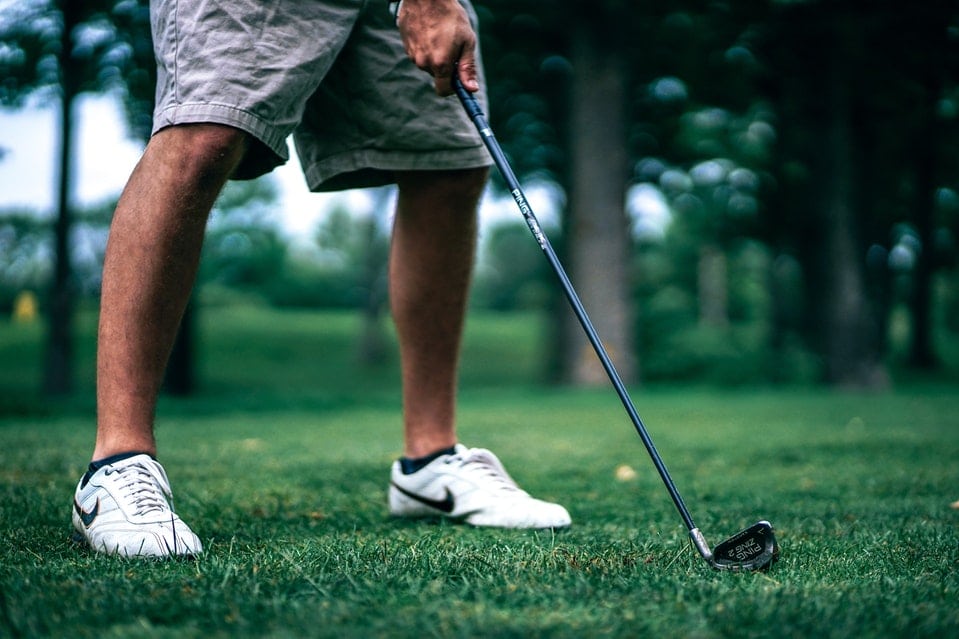
CONCLUSION
How to Grip Golf Club: Now It’s Your Turn
From the driver to the putter, the golf grip is an important, yet often overlooked, fundamental in golf.
Follow these simple guidelines, and you’re well on your way to playing better golf!
1. Use grips that are suited to your hands, your tendencies, and your local climate.
2. Take the time to understand how your hands work together in the golf swing.
3. Practice your grip as often as possible.
4. Once you have a good grip that you trust, don’t change it.
